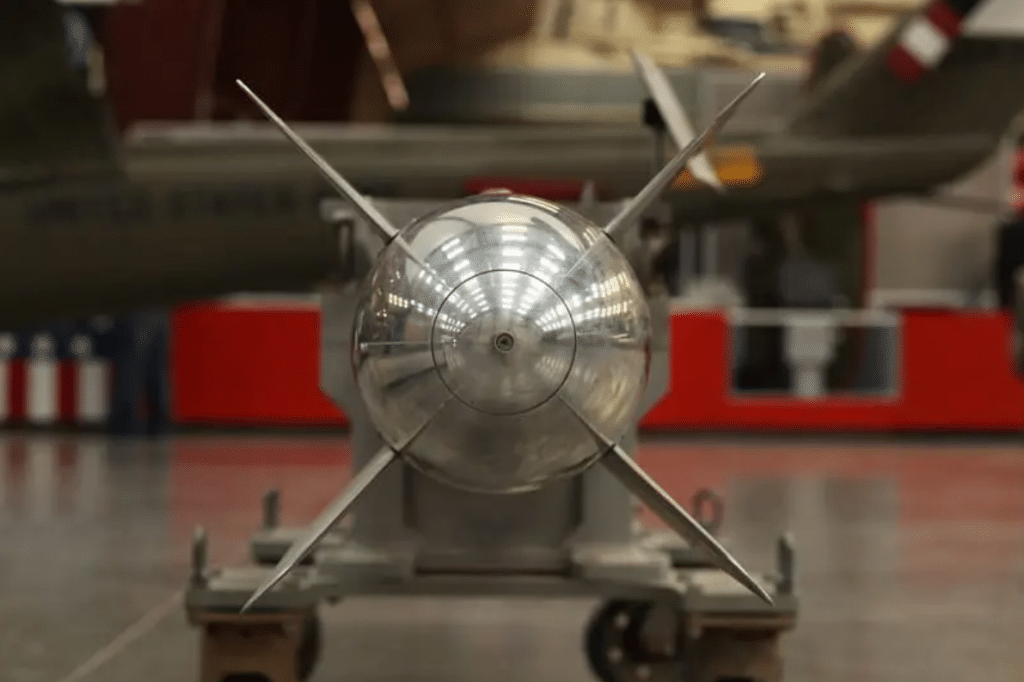The 2020 nuclear landscape, in the shadow of a pandemic
By John Krzyzaniak | December 29, 2020
 A B61 nuclear bomb at the Pima Air and Space Museum.
A B61 nuclear bomb at the Pima Air and Space Museum.
Over the past year, new nuclear risks emerged, old risks reappeared, and, although no risks really went away, there were some positive signs. On the “new” side of the ledger, at the end of last year, the United States began deploying a low-yield nuclear warhead on its ballistic missile submarines. Around the same time, the Russian military put its first Avangard hypersonic missiles into service atop modified SS-19 intercontinental ballistic missiles. For its part, North Korea rolled out some new hardware as well, including a massive new intercontinental ballistic missile and a submarine-launched ballistic missile during an October military parade.
Old risks came back from the dead, too. Iran’s leaders, frustrated by the United States’ unilateral withdrawal from the 2015 nuclear agreement (and no doubt outraged by multiple assassinations and acts of sabotage), continued to gradually ramp up the country’s nuclear enrichment program, exceeding the restrictions imposed by the deal. Separately, the Trump administration reportedly considered carrying out a nuclear test explosion, nearly upending a consensus held by the previous four US presidents that refraining from such testing is in the country’s best interests.
There were, thankfully, some positive developments. The protests against racial injustice in the United States helped spur the US nuclear community to grapple more deeply with, and perhaps begin to rectify, its own systemic racism. Later in the year, the Treaty on the Prohibition of Nuclear Weapons received the 50 ratifications needed to enter force in 2021. Although some experts believe the treaty may ultimately prove destabilizing, others welcome it on the grounds that it will continue strengthening the norm against the possession of nuclear weapons and help drive efforts toward eventual disarmament.
Many nuclear experts also consider Joe Biden’s victory in the 2020 US presidential election a positive as well. Though it appears unlikely that he will substantially alter the US nuclear posture or put a halt to US nuclear modernization plans, he has committed to extending the bilateral New Strategic Arms Reduction Treaty with Russia and rejoining the nuclear agreement with Iran.
Of course, most of these developments took place in the shadow of the COVID-19 pandemic. And although it cannot be considered a nuclear risk, the global public health crisis has offered a window into how world leaders might navigate an analogous crisis in the nuclear realm. Their performances have been hardly reassuring.
Below is a sampling of the Bulletin’s exemplary coverage of these events over the course of 2020.
Cool your jets: Some perspective on the hyping of hypersonic weapons
By Ivan Oelrich
A detailed yet accessible technical analysis makes clear that many of the claims about the revolutionary nature of hypersonic weapons do not withstand scrutiny, particularly when compared to alternatives. Their capabilities are not new, and today most of the missions proposed for hypersonic weapons could be accomplished cheaper and with less technical risk simply by modifying existing ballistic missiles.
The low-yield nuclear warhead: A dangerous weapon based on bad strategic thinking
By Andrew Facini
An examination of the many and varied concerns about the low-yield warhead deployed on US ballistic missile submarines.
How the coronavirus outbreak is like a nuclear attack: An interview with Jeffrey Lewis
John Krzyzaniak and Jeffrey Lewis
An interview with arms control expert Jeffrey Lewis, a professor at the Middlebury Institute for International Studies at Monterey, who compares the early days of the COVID-19 pandemic to how a nuclear crisis might unfold.
India–China border dispute: The curious incident of a nuclear dog that didn’t bark
By Ramesh Thakur and Manpreet Sethi
A lucid analysis of why nuclear bluster was conspicuously absent during the India–China border clashes. The countries’ respective no-first-use policies, the authors argue, likely played a role.
A call for antiracist action and accountability in the US nuclear community
By Katlyn M. Turner, Lauren J. Borja, Denia Djokic, and Madicken Munk
A roadmap for how individuals and institutions in the nuclear community can begin to take on the true work of becoming antiracist by accepting and rectifying their own complicity in the problem.
After the parade, North Korea’s steady progress matters more than its big new missile
By Jenny Town
A brilliant analysis of why even though North Korea’s new intercontinental ballistic missile stole the show, it wasn’t the most important takeaway from the October parade.
The nuclear ban treaty is set to enter force. Experts explain what comes next
With comments from Rebecca Davis Gibbons, Zia Mian, Joelien Pretorus, and Ramesh Thakur
A handful of top nuclear policy experts assess the impact of the Treaty on the Prohibition of Nuclear Weapons’ upcoming entry into force.
Together, we make the world safer.
The Bulletin elevates expert voices above the noise. But as an independent nonprofit organization, our operations depend on the support of readers like you. Help us continue to deliver quality journalism that holds leaders accountable. Your support of our work at any level is important. In return, we promise our coverage will be understandable, influential, vigilant, solution-oriented, and fair-minded. Together we can make a difference.
Keywords: Hypersonic Missile, Iran nuclear deal, JCPOA, hypersonic missiles, low-yield warhead
Topics: Nuclear Risk















